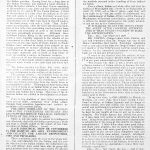April 4, 1919
The Pawhuska Capital
Microfilm Roll: MN00328
A frequent subject of debate in the United States government during the early 20th century was the control of American Indians that led to governmental control of Indian lands, tribal governance, and resources—policies which generally benefited white men. However, on this day in Osage country, an article was posted in The Pawhuska Capital which discussed a white man’s, Congressman McKeown’s, plea to restructure government control over the Indians in way to better assist not just the Five Civilized tribes, but the Osages as well.
Perhaps Mr. McKeown’s firsthand experience with American Indian life provided him with a different perspective on such destructive policies. He states, “Having lived for a long time in Indian Territory and enjoyed a large clientele among the Indian citizens, I feel that I know something of the conditions in my state and the treatment accorded them by the agents of the Indian Bureau.” Shortly after, when finished describing his interactions with Indians in more detail, McKeown follows by pointing out some of the faults in the creation of earlier legislation against American Indians. For instance, the fact that many of the previous policy makers had little to no personal experience with Native Americans and therefore had no knowledge of Indian lifestyle or culture. Or, as McKeown describes the situation, “the average citizen–far removed from the abode of the Indian–looks upon him from the viewpoint of the storybooks of his childhood–much of which was fiction emanating from the fertile brain of an imaginative author.”
With his plea, one could say that Congressman McKeown served as a representative for American Indians by bringing their concerns to the table. He discusses how tribes handled their affairs before the government’s involvement, stating that “prior to the abolition of their tribal government these several tribes conducted their tribal affairs…with marked ability.” Following government collusion, however, McKeown declares that there is “unnecessary restraint and red tape methods of the local representatives of the Indian Bureau.” He then turns the legislature’s attention to the solution, a policy by the Commissioner of Indian affairs, stating, “Each individual must be considered in the light of his own environments and capacity for larger responsibilities and privileges.” Or in simpler terms, one cannot effectively “solve” the question of Indian control by creating a blanket policy or organization, for that matter, based on stereotypes. Later, while quoting another policy from the commissioner of Indian Affairs, McKeown goes on to say, “There is more red tape and more restriction upon the action and freedom of the members today than ever before in the history of the Indian.”
As a counter to the, then, current policies pertaining to Indian control, McKeown calls for reorganization within the Indian Bureau. He calls for the firing of agents who “have nothing in mind toward doing anything for the Indians,” and urges for the “bureau [to] place in the service more competent men and women who will do some actual, earnest, intelligent work to help and assist the Indians under their care.”
Morgan M. Guzman
“Discussion of Government Control of the American Indian by Congressmen.” The Pawhuska Capital. April 4, 1919, p. 4. Microfilm roll number MN00328. Sequoyah National Research Center, Little Rock, Arkansas.
Source File(s)
Related Stories
- Change in Indian Affairs is proposed by Senator Thomas
- Osage and Quapaw Get Their Freedom by Sells’ Order
